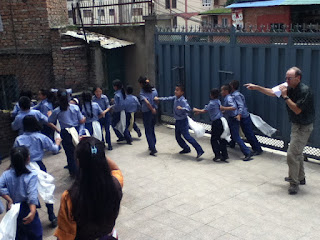 Monkey Saliva Sampling at Swoyumbunath - We were invited to join a research team who is doing DNA analysis of "temple monkeys" in Kathmandu. They are part of the USAID - PREDICT project from UC Davis Veterinary School, trying to identify potential pandemic viral diseases before they jump from primates to humans. Brilliant scientists and researchers, doing fascinating important work. Thanks Dibesh, Tierra, and everyone at the CMDN - Center for Molecular Dynamics, Nepal.
Monkey Saliva Sampling at Swoyumbunath - We were invited to join a research team who is doing DNA analysis of "temple monkeys" in Kathmandu. They are part of the USAID - PREDICT project from UC Davis Veterinary School, trying to identify potential pandemic viral diseases before they jump from primates to humans. Brilliant scientists and researchers, doing fascinating important work. Thanks Dibesh, Tierra, and everyone at the CMDN - Center for Molecular Dynamics, Nepal.
 "Rabbits, Foxes, Leaves" - This is a well-known ecology game that teaches habitat requirements, predator-prey relationships, population changes, and carrying capacity. It's also really fun, loud and crazy!!! The students LOVE running around outside, chasing & screaming, and they're actually learning too. We connected it to our oceans, coral reefs & marine biodiversity lessons, by changing it to "Sharks, Plankton, Fishies." We keep track of each round, or "year," and the populations changes. Next week we will graph the population ups and downs, and talk about the "balance of nature." The only problem is that 40 of these kids are REALLY loud. It is so difficult to quiet them down & get their attention after each round of the game... We need a bullhorn!
"Rabbits, Foxes, Leaves" - This is a well-known ecology game that teaches habitat requirements, predator-prey relationships, population changes, and carrying capacity. It's also really fun, loud and crazy!!! The students LOVE running around outside, chasing & screaming, and they're actually learning too. We connected it to our oceans, coral reefs & marine biodiversity lessons, by changing it to "Sharks, Plankton, Fishies." We keep track of each round, or "year," and the populations changes. Next week we will graph the population ups and downs, and talk about the "balance of nature." The only problem is that 40 of these kids are REALLY loud. It is so difficult to quiet them down & get their attention after each round of the game... We need a bullhorn! 
Swoyumbunath Quake Damage - When we were going out to work with the primate researchers, we also explored the famous hilltop "monkey temple." The main stupa and tower are fairly intact, but some surrounding pillars, monuments, and buildings were totally destroyed. There are lots of workers busting up broken buildings, and hauling away the debris in baskets. Wooden and metal supports prop up ancient temples and structures. But in a few areas, workers are already rebuilding brick walls, and starting the reconstruction. It will probably take many years... The peaceful and spiritual ambience, however, is still intact. It can never be destroyed. The hilltop has great views over the Kathmandu Valley, and Hindu religious singers provide constant background music. There is such an interesting mix of religions as well... Hindu temples surround the famous Buddhist stupa. Some of the Hindu shrines actually have Tibetan style Buddhist prayer wheels mounted into their outer walls. Hindus believe that Buddha was a Hindu, and the reincarnation of Vishnu, so in Nepal there is a lot of overlap among these groups. It's great to see such religious tolerance and respect!





No comments:
Post a Comment